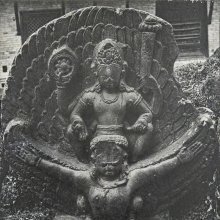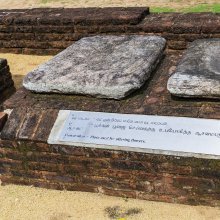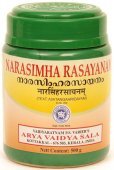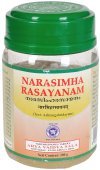Asana, Āśana, Āsana, Aśanā, Aśana, Ashana, Asaṇā: 58 definitions
Introduction:
Asana means something in Buddhism, Pali, Hinduism, Sanskrit, Jainism, Prakrit, the history of ancient India, Marathi, Hindi, biology. If you want to know the exact meaning, history, etymology or English translation of this term then check out the descriptions on this page. Add your comment or reference to a book if you want to contribute to this summary article.
The Sanskrit terms Āśana and Aśanā and Aśana can be transliterated into English as Asana or Ashana, using the IAST transliteration scheme (?).
Images (photo gallery)
(+116 more images available)
In Hinduism
Purana and Itihasa (epic history)
Source: Wisdom Library: PurāṇasĀsana (आसन) is a Sanskrit technical term translating to “posture”. It is used throughout vedic and purāṇic literature.
Source: archive.org: Puranic EncyclopediaĀsana (आसन).—Posture in Yogābhyāsa. There are different types of āsanas. The chief of them are given below: Bhujaṅgāsana. Lying flat, face downwards on a sheet with hands placed close to the body on either side. After relaxing all the muscles of the body, concentrate the mind on health. Keeping the feet close together and pressing the knees against the ground, raise the soles upwards to the sky. Place both palms, pressing against the ground, touching the shoulders on both sides. Then raise the head and bend the neck backwards as far as possible. At this time, the trunk and legs should be in close contact with the ground. Gradually raise the chest, supported by the hands on the ground. Bring the head down in the same way as it was raised and restore the body to its former position. This āsana strengthens the backbone. Śalabhāsana. Lie flat on the sheet, face downwards. Keep the legs close together and raise the feet up with the heels touching each other. Place the hands close to the body on either side and close the fists upwards. Place the fists and shoulders close to the ground and make the whole body stiff after inhaling the breath. Then try to raise the legs. Support the weight of the body with the breast and hands. This is possible by pressing the fists, firmly against the ground. Until the āsana is completed, do not send out the breath. Keep the legs straight and stiff. The lower abdomen and legs may be raised slightly. This makes the āsana complete. On feeling suffocation, the legs must be brought down slowly.
Besides these, there are many other āsanas like Dhanurāsana, Paścimātānāsana, Halāsana, Mayūrāsana, Sarvāṅgāsana, Matsyāsana, Śīrṣāsana, Arddhamatsyendrāsana, Pādahastāsana, Trikoṇāsana, Uḍḍīyāsana, Nauli, Viparītakaraṇi, Yogamudrā, Śavāsana, etc. (See under Yoga). (See full article at Story of Āsana from the Puranic encyclopaedia by Vettam Mani)
Source: archive.org: Shiva Purana - English Translation1) Āsana (आसन) refers to “offering the seat” and represents one of the sixteen upacāra, or “sixteen types of homage and services”, as described while explaining the mode of worshipping the phallic form (liṅga) of Śiva in the Śivapurāṇa 1.11. Accordingly, “[...] the devotee shall worship the mobile emblem with the sixteen types of homage and services (upacāra) as prescribed. It accords the region of Śiva gradually. The sixteen types of service are [for example, offering the seat (āsana)] [...] Or he shall perform all the sixteen rites in the phallic emblem of human, saintly or godly origin, or in one naturally risen up (svayambhū) or in one of very extraordinary nature installed duly”.
2) Āsana (आसन) refers to a “seat”, which one should make after taking a bath (snāna), according to the Śivapurāṇa 2.1.13, while explaining the mode of worshipping Śiva:—“[...] in a clean place washed and smeared with cow-dung (gomaya), the devotee shall take his seat (āsana), O Brahmins. The seat shall be made of wood (kāṣṭha) or a cloth-cover. A seat of diverse colours (citrāsana) is conducive to the achievement of all desires. Or he can have the hide of a deer (mṛgacarma) for a seat. He shall sit on it and apply Tripuṇḍra with the ashes”.
3) Aśana (अशन) refers to “serving food and water” [?], according to the Śivapurāṇa 2.3.54 (“Description of the duties of the chaste wife”).—Accordingly, as a Brahmin lady said to Pārvatī: “[...] She who delights her husband delights all the worlds. When she sees her husband coming home she shall hasten to serve him (aśana) food and water [tvaritānnajalāśanaiḥ], hand him betel and change of garments, and serve him by massaging his feet. By pleasing words she shall fascinate him and dispel his gloom. [...]”.
Source: Cologne Digital Sanskrit Dictionaries: The Purana Index1) Aśanā (अशना).—The queen of Bali, and mother of Bāṇa and other sons.*
- * Bhāgavata-purāṇa VI. 18. 17.
2) Āsana (आसन).—(Svastikam, Padmam) and ardhāsana—the sitting posture of the pāśupata yoga;1 a kind of dharaṇā.2

The Purana (पुराण, purāṇas) refers to Sanskrit literature preserving ancient India’s vast cultural history, including historical legends, religious ceremonies, various arts and sciences. The eighteen mahapuranas total over 400,000 shlokas (metrical couplets) and date to at least several centuries BCE.
Ayurveda (science of life)
Kalpa (Formulas, Drug prescriptions and other Medicinal preparations)
Source: Shodhganga: Edition translation and critical study of yogasarasamgrahaAsana (असन) refers to the medicinal plant known as “Pterocarpus marsupium Roxb.” and is dealt with in the 15th-century Yogasārasaṅgraha (Yogasara-saṅgraha) by Vāsudeva: an unpublished Keralite work representing an Ayurvedic compendium of medicinal recipes. The Yogasārasaṃgraha [mentioning asana] deals with entire recipes in the route of administration, and thus deals with the knowledge of pharmacy (bhaiṣajya-kalpanā) which is a branch of pharmacology (dravyaguṇa).
Toxicology (Study and Treatment of poison)
Source: Shodhganga: Kasyapa Samhita—Text on Visha ChikitsaAsana (असन) is the name of an ingredient used in the treatment of rat-poison such as those caused by the Karaghna-rats, according to the Kāśyapa Saṃhitā: an ancient Sanskrit text from the Pāñcarātra tradition dealing with both Tantra and Viṣacikitsā—an important topic from Āyurveda which deals with the study of Toxicology (Viṣavidyā or Sarpavidyā).—Accordingly, one of the treatments is mentioned as follows: “Paste of Nirguṇḍī sprouts must be applied with Mustā, Triphalā and pepper must be eaten with jaggery. Fumigation must be done with Gula and leaves of Asana with sumptuous milk”.
Unclassified Ayurveda definitions
Source: Wisdom Library: Āyurveda and botanyAsana (असन) is a Sanskrit word referring to the “Indian laurel”, a species of tree from the Combretaceae family of flowering plants, and is used throughout Ayurvedic literature such as the Caraka-saṃhitā. It is also known by the names Bījaka in Sanskrit, and Bijasāl, Vijaysār or Bīā in Hindi, Vēṅkai in Tamil and Vēṅṅa in Malayalam.. The official botanical name of the plant is Terminalia tomentosa and is commonly known as “Asna”, “Saj”, “Indian-laurel” or “Indian kino tree” among many others.
Source: Google Books: Essentials of AyurvedaAsana (असन).—The Sanskrit name for an important Ayurvedic drug.—It is also known as Bījaka having prominent heart-wood which is used as drug. It is rough, cold, astringent and useful in prameha and kuṣṭha.
Source: archive.org: Vagbhata’s Ashtanga Hridaya Samhita (first 5 chapters)Aśana (अशन) refers to “food” or “herbs”, and is mentioned in verse 2.40-44 and 5.24 of the Aṣṭāṅgahṛdayasaṃhitā (Sūtrasthāna) by Vāgbhaṭa.—Accordingly, “[...] taking food, (enjoying) women, sleeping, reading, and thinking at dawn and dusk; food [viz., aśana] (originating) from enemies, sacrifices, vagrants, meetings, harlots, and traders[...] (all these things) one shall eschew. In all activities of a wise (man) the world alone (is) his teacher”.
Note: Aśana (“food”) has been put in the plural: zas-dag (“eatables, victuals”).
Source: Advances in Zoology and Botany: Ethnomedicinal List of Plants Treating Fever in Ahmednagar District of Maharashtra, India1) Asaṇa in the Marathi language refers to the medicinal tree “Bridelia retusa (Linn.) Spreng.”, and is used for ethnomedicine treatment of Fever in Ahmednagar district, India. The parts used are: “Stem bark”.
2) Asaṇā in the Marathi language refers to the medicinal tree “Bridelia retusa (Linn.) Spreng.”, and is used for ethnomedicine treatment of Fever in Ahmednagar district, India. The parts used are: “Stem bark”.
Source: gurumukhi.ru: Ayurveda glossary of terms1) Aśana (अशन):—Eatables;
2) Āsana (आसन):—Physical Postures

Āyurveda (आयुर्वेद, ayurveda) is a branch of Indian science dealing with medicine, herbalism, taxology, anatomy, surgery, alchemy and related topics. Traditional practice of Āyurveda in ancient India dates back to at least the first millenium BC. Literature is commonly written in Sanskrit using various poetic metres.
Shilpashastra (iconography)
Source: Google Books: Elements of Hindu iconographyĀsana (आसन, “sitting postures and sears”).—The sciens of yoga described various postures of sitting, as suitable for meditation and mental concentration. These sitting postures are technically known by the name of āsanas; and the kūrmāsana, the padmāsana, the bhadrāsana, the utkuṭikāsana and the makarāsana, are some of the varieties thereof. A few of them occur in sculpture, as well. The names of some of these sitting postures have been interpreted to mean particular forms of seats, owing to the ambiguity of the word āsana, and such seats have been worked out in sculpture; as instances the kūrmāsana (represented as a tortoise), the makarāsana (represented as a mythical makara) and the padmāsana (represented as a lotus) a may be noted.
The word āsana means also a seat or a pedestal. In this sense pīṭha is often used as its synonym. Descriptions of material āsanas of this kind are met with in Sanskrit works treating of the make-up of images.
Source: Shodhganga: The significance of the mūla-beras (śilpa)Āsana (आसन) refers to “body postures”, and forms one of the three divisions of pratimālakṣaṇa (body postures of the icons), as defined according to texts dealing with śilpa (arts and crafs), known as śilpaśāstras.—The divine postures of the deities are called āsanas. There is also another meaning, that is, the originating pose.
Ganapati Sthapati in his text Ciṟpa Cennūl describes the five āsanas as
- sthānaka–the standing pose,
- āsana–the sitting pose,
- śayana–the reclining pose,
- sthānāsana (the pose dependent on the sthānaka) and
- śayanāsana (the pose dependent on the reclining pose).
The āsanas also serve as the pedestals. The word āsanā can also mean a seat or even a pedestal; in the latter sense, the word pīṭha is frequently used. Thus, padmapīṭha would indicate the lotus seat on which the deities are often seated.
Source: Shodhganga: Vaisnava Agamas And Visnu ImagesĀsana (आसन) or Sthāna refers to “postures”, as defined in treatises such as the Pāñcarātra, Pādmasaṃhitā and Vaikhānasa-āgamas, extensively dealing with the technical features of temple art, iconography and architecture in Vaishnavism.

Shilpashastra (शिल्पशास्त्र, śilpaśāstra) represents the ancient Indian science (shastra) of creative arts (shilpa) such as sculpture, iconography and painting. Closely related to Vastushastra (architecture), they often share the same literature.
Dharmashastra (religious law)
Source: Wisdom Library: Dharma-śāstraĀsana (आसन) is a Sanskrit technical term, used in warfare, referring to “staying quiet” (eg., for strengthening the self or for the fulfilment of victory). Āsana is considered to be one of the six constituents of state-craft that the King shall constantly ponder over. The word is used throughout Dharmaśāstra literature such as the Manusmṛti. (See the Nītiprakāśikā 8.83 and the Manubhāṣya 7.160)
Source: Google Books: Manusmṛti with the Manubhāṣya1) Āsana is ‘staying within one’s own territories, not minding the war that may have been declared. (See the Manubhāṣya verse 7.160 et. seq.)
Halting is of two kinds—
- done on account of weakness,
- and done for the purpose of waiting to help an ally.
2) Āsana, Entrenching, is that step by which one protects himself but destroys the enemy.

Dharmashastra (धर्मशास्त्र, dharmaśāstra) contains the instructions (shastra) regarding religious conduct of livelihood (dharma), ceremonies, jurisprudence (study of law) and more. It is categorized as smriti, an important and authoritative selection of books dealing with the Hindu lifestyle.
Yoga (school of philosophy)
Source: Wisdom Library: YogaĀsana (आसन, “posture”) is a Sanskrit word referring to “harmony with your body”. It is one of the eight brances of yoga, also known as the eightfold-path (aṣṭānga). Also see the fifth section of the Varāha-upaniṣad.
There are eleven postures (āsana) mentioned:
- cakrāsana,
- padmāsana,
- kūrmāsana,
- mayūrāsana,
- kukktāsana,
- vīrāsana,
- svastikāsana,
- bhadrāsana,
- siṃhāsana,
- muktāsana,
- gomukhāsana.
Āsana (आसन) refers to one of the seven auxiliaries of Haṭhayoga, according to the 17th-century Haṭhayogasaṃhitā: a compilation on Haṭhayoga that borrows extensively from the Haṭhapradīpikā.—[...] The stated aim of Haṭhayoga is to achieve purification (śodhana), firmness (dṛḍhatā), steadiness (sthairya), constancy (dhairya), lightness (lāghava), direct perception (pratyakṣa) and liberation (nirlipta) of the body (ghaṭa). Its Haṭhayoga has seven auxiliaries: the ṣaṭkarma, āsana, mudrā, pratyāhāra, prāṇasaṃyāma, dhyāna and samādhi.

Yoga is originally considered a branch of Hindu philosophy (astika), but both ancient and modern Yoga combine the physical, mental and spiritual. Yoga teaches various physical techniques also known as āsanas (postures), used for various purposes (eg., meditation, contemplation, relaxation).
Natyashastra (theatrics and dramaturgy)
Source: Wisdom Library: Nāṭya-śāstraĀsana (आसन) refers to a “seats” (sitting postures); it is a Sanskrit technical term defined in the Nāṭyaśāstra chapter 12.
There are two kinds of seats (āsana) defined:
- bāhya (public),
- ābhyantara (private).

Natyashastra (नाट्यशास्त्र, nāṭyaśāstra) refers to both the ancient Indian tradition (shastra) of performing arts, (natya—theatrics, drama, dance, music), as well as the name of a Sanskrit work dealing with these subjects. It also teaches the rules for composing Dramatic plays (nataka), construction and performance of Theater, and Poetic works (kavya).
Shaktism (Shakta philosophy)
Source: Google Books: ManthanabhairavatantramĀsana (आसन) refers to the “seats” (on which the upper portion of the Liṅga is placed).—The Triangle is called the Stone [i.e., śilā] and is identified with the Stone or Mountain the goddess ascends in the myth to assume the form of a Liṅga. The original model for this “stone” is probably the base of what, according to the Siddhānta, consists of the seats (āsana) on which the upper portion of the Liṅga is placed. The Liṅga and its seats extend for the entire series of thirty-six principles. The seats, according to some texts, reach up to Śakti and according to others, Śiva. [...] What interests us here is the energy at the base of the seats. This is called the energy of the foundation (ādhāraśakti) and it inheres in the foundation stone (ādhāraśilā) of the Liṅga, which corresponds to the Earth principle. [...]
Source: academia.edu: The Śāradātilakatantra on YogaĀsana (आसन, “posture”) is explained by Lakṣmaṇadeśika in his 11th-century Śaradātilaka.—Āsanas are enumerated as the third limb of yoga: padmāsana, svastikāsana, bhadrāsana, vajrāsana and vīrāsana, and are described individually (9cd–16ab). As one would expect, the definitions and names of the postures are not identical in all texts on yoga.

Shakta (शाक्त, śākta) or Shaktism (śāktism) represents a tradition of Hinduism where the Goddess (Devi) is revered and worshipped. Shakta literature includes a range of scriptures, including various Agamas and Tantras, although its roots may be traced back to the Vedas.
Shaivism (Shaiva philosophy)
Source: archive.org: SardhatrisatikalottaragamaĀsana (आसन) means “making a seat of darbha” which is prescribed as one of the operations/ preliminary ceremonies related to the kuṇḍa (“fire-pit”), according to the various Āgamas and related literature. Āsana is mentioned in the Raurava-āgama (Kriyā-pāda, chapter 15).
Source: Shodhganga: Mantra-sādhana: Chapter One of the KakṣapuṭatantraĀsana (आसन) refers to the “seat” and “posture” used while performing mantrasādhana (preparatory procedures), mentioned in detail in the Kakṣapuṭatantra verse 1.60, “Having gotten to the seats as described, the mantrin should practice japa. On the seat prepared with kuśa grass, hairy skin, or cotton, and with four corners (i.e., square) with four aṅgulas in height, two hastas long, which is very strong, and made soft, one should practice yoga to make a mantra effective”.
Source: Brill: Śaivism and the Tantric Traditions1) Aśana (अशन) refers to “(the urge to) eat”, according to the Guhyasūtra chapter 3.—Accordingly, “[...] One may perform the Block-of-Wood Observance in a forest full of bears, tigers and lions, conquering the urges to sleep and eat (aśana), [constantly] reciting. If one takes on the appearance of a woman and sings and dances, adorned with bracelets, with a winnowing fan, ball and plait, one observes the Colourful Observance. With a weapon in hand, full of compassion, if one wanders like a saviour of creatures (?) focussed upon recitation, meditation and worship, one performs the Warrior Observance. [...]”.
2) Āsana (आसन) refers to the “lotus-seats (of the mantra-deities)”, according to the Brahmayāmala-tantra (or Picumata), an early 7th century Śaiva text consisting of twelve-thousand verses.—[The padmamālā-vidhi prescribes installing deities within series of nine, seven and eight lotuses].—The Brahmayāmala’s series of lotuses do not in any simple sense represent “structures” of a subtle or “yogic” anatomy. The lotus-seats (āsana) of the mantra-deities are created through meditative visualization: one actively engenders a divine body of mantra rather than reifying a subtle reality already latent in the body. [...]
3) Āsana (आसन) refers to a “(soft) cushion”, according to the 13th-century Matsyendrasaṃhitā: a Kubjikā-Tripurā oriented Tantric Yoga text of the Ṣaḍanvayaśāmbhava tradition from South India.—Accordingly, “[Visualisation of Parameśvara]:—In a hidden sanctuary, the mantra master should sit on a soft cushion (mṛdu-āsana-parigraha) and should visualise himself as having the body of Parameśvara, as if [he were transformed into] Kāmeśvara, having no beginning and no end, shining like millions of suns. [...] ”.
Source: SOAS University of London: Protective Rites in the Netra TantraĀsana (आसन) refers to “seats” (in dreams), according to the Svacchanda-tantra.—Accordingly, [verse 4.21-27, while describing inauspicious dreams]—“[...] [He dreams of] the destruction of houses, palaces, beds, clothes, and seats (āsana—śayyāvastrāsaneṣu); defeat of oneself in battle and theft of ones things. [He] ascends or is amongst donkeys, camels, dogs, jackals, and herons, vultures, and cranes. [He rides on] buffalos, owls, and crows, eats cooked meat, [wears a] red garland, and ointment for the body. [...]”

Shaiva (शैव, śaiva) or Shaivism (śaivism) represents a tradition of Hinduism worshiping Shiva as the supreme being. Closely related to Shaktism, Shaiva literature includes a range of scriptures, including Tantras, while the root of this tradition may be traced back to the ancient Vedas.
Vaishnavism (Vaishava dharma)
Source: Pure Bhakti: Bhagavad-gita (4th edition)Āsana (आसन) refers to “(1) Seat (2) Sitting posture for meditation”. (cf. Glossary page from Śrīmad-Bhagavad-Gītā).
Source: Pure Bhakti: Arcana-dipika - 3rd EditionĀsana (आसन) refers to a “seat” and represents one of the various articles offered during worship, according to the Arcana-dīpikā (manual on deity worship), while explaining procedures performed in the morning.—According to time and place, sixteen [viz., āsana], twelve, ten or five articles can be employed in the worship of Śrī Bhagavān.

Vaishnava (वैष्णव, vaiṣṇava) or vaishnavism (vaiṣṇavism) represents a tradition of Hinduism worshipping Vishnu as the supreme Lord. Similar to the Shaktism and Shaivism traditions, Vaishnavism also developed as an individual movement, famous for its exposition of the dashavatara (‘ten avatars of Vishnu’).
Jyotisha (astronomy and astrology)
Source: Wisdom Library: Brihat Samhita by VarahamihiraĀsana (आसन) refers to “seats”, according to the Bṛhatsaṃhitā (chapter 2), an encyclopedic Sanskrit work written by Varāhamihira mainly focusing on the science of ancient Indian astronomy astronomy (Jyotiṣa).—Accordingly, “A true Astrologer is also one who has thoroughly mastered the Science of Saṃhitā. [...] It also treats of the prediction of events from the flight of the kañjana and from the appearance of various abnormal phenomena, of expiatory ceremonies; of miscellaneous planetary phenomena; of ghṛta-kambala; of the royal sword; of paṭa; of the features of a house cock, a cow, a sheep, a horse, an elephant, a man and a woman. It also treats of the treatment of women; of moles in the body; of injuries to shoes and clothes; of hairy fans; of walking sticks: of beds and seats [i.e., āsana]; of lamplight; of tooth brush and the like”.

Jyotisha (ज्योतिष, jyotiṣa or jyotish) refers to ‘astronomy’ or “Vedic astrology” and represents the fifth of the six Vedangas (additional sciences to be studied along with the Vedas). Jyotisha concerns itself with the study and prediction of the movements of celestial bodies, in order to calculate the auspicious time for rituals and ceremonies.
Pancaratra (worship of Nārāyaṇa)
Source: University of Vienna: Sudarśana's Worship at the Royal Court According to the AhirbudhnyasaṃhitāAśana (अशन) refers to “thunderbolts”, according to the Ahirbudhnyasaṃhitā, belonging to the Pāñcarātra tradition which deals with theology, rituals, iconography, narrative mythology and others.—Accordingly, “An abnormal modification caused by a aggressive ritual against Kings, occurring at the improper time, dreadful and all-reaching, is characterized by the these signs: Suddenly horses, elephants and ministers perish, the king himself suffers from a serious illness which has seized [his] body; terrifying thunderbolts (patantī-aśana) strike his dominion; [...] from such and other signs he should understand that the enemy is performing a aggressive ritual”.
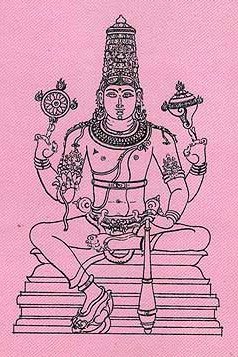
Pancaratra (पाञ्चरात्र, pāñcarātra) represents a tradition of Hinduism where Narayana is revered and worshipped. Closeley related to Vaishnavism, the Pancaratra literature includes various Agamas and tantras incorporating many Vaishnava philosophies.
Sports, Arts and Entertainment (wordly enjoyments)
Source: archive.org: Syainika Sastra of Rudradeva with English Translation (art)Aśana (अशन) refers to the “eating habits” (of hawks), according to the Śyainika-śāstra: a Sanskrit treatise dealing with the divisions and benefits of Hunting and Hawking, written by Rājā Rudradeva (or Candradeva) in possibly the 13th century.—Accordingly, [while discussing the training of hawks]: “[The black-eyed class] can be tamed by much ‘watching’. It eats (aśana) flesh and drinks water [sapānīyāmiṣāśanaḥ]. If it bites the falconer’s hand, stones are to be presented to it. Their feigned or apparent confidence can easily be acquired, but to gain their real confidence is difficult, therefore great care should be taken in their training”.
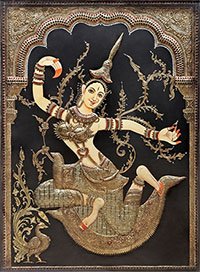
This section covers the skills and profiencies of the Kalas (“performing arts”) and Shastras (“sciences”) involving ancient Indian traditions of sports, games, arts, entertainment, love-making and other means of wordly enjoyments. Traditionally these topics were dealt with in Sanskrit treatises explaing the philosophy and the justification of enjoying the pleasures of the senses.
General definition (in Hinduism)
Source: Wisdom Library: HinduismAsana (असन)—Sanskrit word for the plant Terminalia tomentosa or Pterocarpus marsupium.
Source: WikiPedia: HinduismĀsana is thus a posture that one can hold for a period of time, staying relaxed, steady, comfortable and motionless. Patanjali does not list any specific āsana, except the terse suggestion, “posture one can hold with comfort and motionlessness”.
Hariharānanda Āraṇya translates verse II.47 of Yoga sūtra as, “āsanas are perfected over time by relaxation of effort with meditation on the infinite”; this combination and practice stops the quivering of body.
Source: ACHC: Smarta PujaĀsana (आसन) refers to “presenting a seat”, representing one of the various services (upacāra) of a pūjā (ritualistic worship of a deity) which aim at the purification of the devotee.—With the second verse of the Puruṣa-sūkta the deity is offered a tulasī (Ocimum sanctum, holy basil leaf as a substitute for a seat (āsana) which is decorated with gold and jewels. The offering of a seat to deities is a custom known from Vedic times; compare the invitation of king Soma to the Vedic fire-sacrifice.
Source: Shodhganga: Temples and cult of Sri Rama in Tamilnadu (h)Asana refers to “offering a seat for the God” and represents one of the various daily ceremonies performed during puja (worship).—Offering of water and food or tirtham and prasadam to the deities on the different occasions or specified hours of the day is an important item in the daily pujas. [...] While for the daily routine, only ordinary plain rice was offered, special food preparations were offered often on festival days. [...] The daily routine includes a number of ceremonies [viz., Asana] that are repeated.
In Buddhism
Mahayana (major branch of Buddhism)
Source: Wisdom Library: Maha Prajnaparamita SastraĀsana (आसन) refers to “seats”, according to Mahāprajñāpāramitāśāstra (chapter 4).—Accordingly, “[The Buddha] is single-minded (ekacitta), without duality (advaya). In all things, whatever they may be, food and drink (āhāra), robes and clothing (paṭa-vasana), beds and seats (śaya-āsana), praise and blame (varṇana-vijṛmbhā), mistrust and respect (vitaṇḍana-gaurava), the Buddha’s mind remains indifferent. It is like pure gold which, even when burned, melted, beaten or polished, shows no increase or decrease. [On the contrary], the Arhats, although they have broken the bonds (bandhana) and have found the Path, still retain the traces (vāsana) [of the passions]; this is why they cannot be called Bhagavat”.

Mahayana (महायान, mahāyāna) is a major branch of Buddhism focusing on the path of a Bodhisattva (spiritual aspirants/ enlightened beings). Extant literature is vast and primarely composed in the Sanskrit language. There are many sūtras of which some of the earliest are the various Prajñāpāramitā sūtras.
In Jainism
General definition (in Jainism)
Source: archive.org: Jaina YogaAśana (अशन) refers to “food that is swallowed” and represents one of the four classifications of food (āhāra) according to the 11th century Śrāvakācāra (verse 6.96-97) by Amitagati. Aśana refers to grains and pulses of all kinds, particularly the staple, boiled rice. Forbidden foods falling under this head include meat and the tuberous vegetables, which are condemned as ananta-kāyas. Dairy products are also sometimes covered by this designation.
Source: archive.org: Een Kritische Studie Van Svayambhūdeva’s PaümacariuĀśana (आशन) participated in the war between Rāma and Rāvaṇa, on the side of the latter, as mentioned in Svayambhūdeva’s Paumacariu (Padmacarita, Paumacariya or Rāmāyaṇapurāṇa) chapter 57ff. Svayambhū or Svayambhūdeva (8th or 9th century) was a Jain householder who probably lived in Karnataka. His work recounts the popular Rāma story as known from the older work Rāmāyaṇa (written by Vālmīki). Various chapters [mentioning Āśana] are dedicated to the humongous battle whose armies (known as akṣauhiṇīs) consisted of millions of soldiers, horses and elephants, etc.
Source: archive.org: The Jaina IconographyĀsana (आसन) refers to “postures”, commonly depicted in Jain iconography.—It is well-known that the Indian Yogīs practise the various Āsanas to gain some control of the body, proceeding as they do, towards the Rāja-yoga or higher mental culture. The Jaina Tīrthaṃkaras were also essentially Yogīs on one hand and teachers of religion on the other. Hence, the explanation of the Yogic Āsanas and Mudrās as found in the sculptures of the Jainas, their followers and attendants. In this respect, however, the Jaina Iconography presents some novel features. For some of the Āsanas, for example, the Kāyotsarga, are distinctly of Jaina origin.
Five kinds of Āsanas may be differentiated. These are the Paryaṅka, Ardhaparyaṅka, Vajra, Khaḍgāsana and Vīra. They are also known as Mokṣāsana or the postures assumed by a Jina at the time of the salvation or on the way to attaining it. There is, further, another Āsana called the Bandhurāsana, which has been defined as the easy posture, the assumption of which makes the mind motionless.
Source: archive.org: TrisastisalakapurusacaritraĀśana (आशन) refers to “solid food” and represents one of the four types of food, as mentioned in chapter 1.1 [ādīśvara-caritra] of Hemacandra’s 11th century Triṣaṣṭiśalākāpuruṣacaritra: an ancient Sanskrit epic poem narrating the history and legends of sixty-three illustrious persons in Jainism.—Accordingly, “[...] together with abandonment of all censurable activities the noble man [i.e., Mahābala] renounced the four kinds of food [viz., āśana]. Constantly immersed in the pool of nectar of abstract meditation, he, like a lotus-bed, did not fade at all. He, the crest-jewel of the noble, had undiminished beauty, as if he had been eating food and taking drink”.

Jainism is an Indian religion of Dharma whose doctrine revolves around harmlessness (ahimsa) towards every living being. The two major branches (Digambara and Svetambara) of Jainism stimulate self-control (or, shramana, ‘self-reliance’) and spiritual development through a path of peace for the soul to progess to the ultimate goal.
India history and geography
Source: Cologne Digital Sanskrit Dictionaries: Indian Epigraphical GlossaryĀsana.—(IE 8-8), a seat. Cf. a-cāra-asana-carm-āṅgāra (IE 8-5; EI 15), probably, camping [of the royal officers in a village]; āsana-carma is sometimes taken as one expression meaning ‘a hide seat’. Note: āsana is defined in the “Indian epigraphical glossary” as it can be found on ancient inscriptions commonly written in Sanskrit, Prakrit or Dravidian languages.

The history of India traces the identification of countries, villages, towns and other regions of India, as well as mythology, zoology, royal dynasties, rulers, tribes, local festivities and traditions and regional languages. Ancient India enjoyed religious freedom and encourages the path of Dharma, a concept common to Buddhism, Hinduism, and Jainism.
Biology (plants and animals)
Source: Wisdom Library: Local Names of Plants and DrugsAsana [ಅಸನ] in the Kannada language is the name of a plant identified with Breynia retusa (Dennst.) Alston from the Phyllanthaceae (Amla) family having the following synonyms: Phyllanthus retusus, Breynia patens. For the possible medicinal usage of asana, you can check this page for potential sources and references, although be aware that any some or none of the side-effects may not be mentioned here, wether they be harmful or beneficial to health.
Asana in the Marathi language is the name of a plant identified with Pterocarpus marsupium Roxb. from the Fabaceae (Pea) family having the following synonyms: Pterocarpus bilobus, Lingoum marsupium.
Asana in the Sanskrit language, ibid. previous identification.
Asana in the Telugu language, ibid. previous identification.
Asana in the Sanskrit language is the name of a plant identified with Myristica malabarica Lam. from the Myristicaceae (Nutmeg) family.
Asana [असणा] in the Marathi language is the name of a plant identified with Bridelia retusa (L.) A.Juss. from the Phyllanthaceae (Amla) family.
Asana [ಆಸನ] in the Kannada language, ibid. previous identification.
Asana [आसन] in the Sanskrit language, ibid. previous identification.
Source: Google Books: CRC World Dictionary (Regional names)1) Asana in India is the name of a plant defined with Butea monosperma in various botanical sources. This page contains potential references in Ayurveda, modern medicine, and other folk traditions or local practices It has the synonym Rudolphia frondosa (Willd.) Poir. (among others).
2) Asana is also identified with Hardwickia binata.
3) Asana is also identified with Pterocarpus marsupium It has the synonym Pterocarpus marsupium fo. acuta Prain (etc.).
4) Asana is also identified with Terminalia alata It has the synonym Pentaptera tomentosa Roxb. ex DC., nom. illeg., nom. superfl. (etc.).
5) Asana is also identified with Terminalia tomentosa.
6) Asana in Philippines is also identified with Pterocarpus indicus It has the synonym Lingoum santalinum (L.f.) Kuntze (etc.).
Example references for further research on medicinal uses or toxicity (see latin names for full list):
· Flore Forestière de la Cochinchine (1898)
· Plants of the Coast of Coromandel (1799)
· Natural history (1897)
· Botanical Magazine (Tokyo) (1935)
· Asiatic Researches (1792)
· Journal of Economic and Taxonomic Botany (1996)
If you are looking for specific details regarding Asana, for example extract dosage, chemical composition, side effects, diet and recipes, pregnancy safety, health benefits, have a look at these references.

This sections includes definitions from the five kingdoms of living things: Animals, Plants, Fungi, Protists and Monera. It will include both the official binomial nomenclature (scientific names usually in Latin) as well as regional spellings and variants.
Languages of India and abroad
Pali-English dictionary
Source: BuddhaSasana: Concise Pali-English Dictionaryasana : (nt.) 1. eating; 2. food; 3. an arrow. (m.) the tree Pentaptera Tomentosa. || āsana (nt.), a seat; sitting down.
Source: Sutta: The Pali Text Society's Pali-English Dictionary1) Asana, 4 (nt.) (cp. Sk. asanā, to asyati to hurl, throw) an arrow M. I, 82 = S. I, 62. Cp. asani. (Page 87)
2) Asana, 3 (nt.) (Sk. asana) the tree Pentaptera Tomentosa J. I, 40 (as Bodhi-tree of Gotama); II, 91; V, 420; VI, 530. (Page 87)
3) Asana, 2 (nt.) (cp. Sk. aśana of aś, cp. asati) eating, food; adj. eating J. I, 472 (ghatâsana Ep. of the fire; V, 64 (id.). Usually in neg. form anasana fasting, famine, hunger Sn. 311 (= khudā SnA 324); DA. I, 139. See also nirasana. (Page 87)
4) Asana, 1 (nt.) (Vedic aśan(m)) stone, rock J. II, 91; V, 131. (Page 87)
— or —
1) Āsana, 2 (?) eating Vism. 116 (visam°, cp. visam-āsita Miln. 302). See, however, māsana. (Page 114)
2) Āsana, (nt.) (from āsati) sitting, sitting down; a seat, throne M. I, 469; Vin. I, 272 (= pallaṅkassa okāsa); S. I, 46 (ek° sitting alone, a solitary seat); A. III, 389 (an° without a seat); Sn. 338, 718, 810, 981; Nd1 131; J. IV, 435 (āsān’ûdaka-dāyin giving seat & drink); V, 403 (id.); VI, 413; DhA. II, 31 (dhamm° the preacher’s seat or throne); SnA 401; PvA. 16, 23, 141.

Pali is the language of the Tipiṭaka, which is the sacred canon of Theravāda Buddhism and contains much of the Buddha’s speech. Closeley related to Sanskrit, both languages are used interchangeably between religions.
Marathi-English dictionary
Source: DDSA: The Molesworth Marathi and English Dictionaryaśana (अशन).—n S Eating. 2 Food. Ex. a0 arpuniyā khasukhālayā.
--- OR ---
asaṇa (असण) [or णा, ṇā].—m asaṇī f (āsana S) A wild tree, Terminalia alata tomentosa.
--- OR ---
asāṇā (असाणा).—m (See asaṇā) A wild tree.
--- OR ---
asāna (असान).—n ( A) An obligation or a favor.
--- OR ---
asāna (असान).—a ( P) Easy, facile.
--- OR ---
āsaṇa (आसण) [or णा, ṇā].—See under अ.
--- OR ---
āsana (आसन).—n (S) A seat gen.; a stool, chair, couch, carpet, mat: also a means of conveyance; a horse, bullock, bird, rat &c. (as the bird and rat of viṣṇu & gaṇapati). 2 Continuing in some posture or attitude (as do the Yogis in their devotional exercises): also such posture or attitude, of which eighty-four are enumerated. 3 A column or division of a page. 4 A seat on horseback. ā0 ōḷakhaṇēṃ To know his rider--a horse. ā0 guṇḍāḷaṇēṃ To pack up and move off. ā0 ghālaṇēṃ To take up some sitting posture, esp. āsanamāṇḍī. ā0 jaḍa hōṇēṃ g. of s. To sit fast; to love the sitting posture. 2 To be lifted up; to be elated with pride. ā0 jamaṇēṃ g. of s. To become firmly seated or fixed. 2 To gather densely and fixedly--clouds. Also ā0 jamaviṇēṃ To form one's seat. ā0 jōḍaṇaṃ To squat. ā0 ṭharaṇēṃ g. of s. To get a seat on horseback. ā0 ṭhēvaṇēṃ To mount (a horse &c.) ā0 ḍaḷamaḷaṇēṃ g. of s. To totter in one's seat, lit. fig. 2 To be restless and fidgety. ā0 ḍhaḷaṇēṃ g. of s. To lose one's seat, footing, standing, hold. ā0 paḍaṇēṃ g. of s. To obtain a (seat or fixedness in or at) footing. ā0 basaṇēṃ g. of s. To get a seat (upon horseback). ā0 rundāvaṇēṃ g. of s. Also ā0 vāḍhaṇēṃ g. of s. To get fat, broad, and burly. 2 fig. To acquire greatness and a swelling train. ā0 sōḍaṇēṃ To leave one's proper position, place, or province. āsanīṃ khēḷaṇēṃ To play or stir or revel freely in its own jhāḍa or occupied subject--a devil or fiend. 2 To play pranks and tricks on one's own ground, with one's own means &c. āsanīṃ yēṇēṃ To come round to one's original position.
Source: DDSA: The Aryabhusan school dictionary, Marathi-Englishaśana (अशन).—n Food; eating.
--- OR ---
āsana (आसन).—n A seat; a means of conveyance.
Marathi is an Indo-European language having over 70 million native speakers people in (predominantly) Maharashtra India. Marathi, like many other Indo-Aryan languages, evolved from early forms of Prakrit, which itself is a subset of Sanskrit, one of the most ancient languages of the world.
Sanskrit dictionary
Source: DDSA: The practical Sanskrit-English dictionaryAśana (अशन).—[aś-lyuṭ] a. Reaching, reaching across.
-naḥ Name of a tree = असन (asana) q. v. (Mar. āsaṇā).
-nam 1 Pervasion, penetration.
2) The act of eating, feeding.
3) Tasting, enjoying.
4) Food; अशनं धात्रा मरुकल्पितं व्यालानाम् (aśanaṃ dhātrā marukalpitaṃ vyālānām) Bhartṛhari 3.1; मांसाशनं च नाश्नीयुः (māṃsāśanaṃ ca nāśnīyuḥ) Manusmṛti 5.73; यज्ञशिष्ट° (yajñaśiṣṭa°) 3.118; फलमूलाशनैः (phalamūlāśanaiḥ) 5.54; oft. at the end of adjective comp. in the sense of 'eating', 'one whose food is' &c.; फलमूलाशन, हुताशन, पवनाशन (phalamūlāśana, hutāśana, pavanāśana) &c.
--- OR ---
Aśanā (अशना).—[aśanamicchati aśana-kyac-kvip] Desire to eat, hunger; सुप्तश्चिरं ह्यशनया च भवान्परीतो (suptaściraṃ hyaśanayā ca bhavānparīto) Bhāgavata 6.14.56.
--- OR ---
Asana (असन).—Throwing, discharging, casting; as in इष्वसनम् (iṣvasanam) a bow.
-naḥ Name of a tree (pītasāla) Bridelia retusa (Mar. āsaṇā); Rām.2.94.8; निरसनैरसनैरवृथार्थता (nirasanairasanairavṛthārthatā) Śiśupālavadha 6.47.
-nā Ved. A missile, an arrow.
Derivable forms: asanam (असनम्).
--- OR ---
Āśana (आशन).—a. [aśana-aṇ] One who feeds.
-naḥ 1 Name of a tree (Mar. āsaṇā); see अशन (aśana).
2) The tunderbolt.
--- OR ---
Āsana (आसन).—[ās-lyuṭ]
1) Sitting down.
2) A seat, place, stool; Bhagavadgītā (Bombay) 11.42; स वासवेनासनसन्निकृष्टम् (sa vāsavenāsanasannikṛṣṭam) Kumārasambhava 3.2; आसनं मुच् (āsanaṃ muc) to leave one's seat, rise; R.3.11.
3) A particular posture or mode of sitting; cf. पद्म°, वीर°, भद्र°, वज्र° (padma°, vīra°, bhadra°, vajra°) &c. cf. अनायासेन येन स्यादजस्रं ब्रह्मचिन्तनम् । आसनं तद् विजानीयाद् योगिनां सुखदायकम् (anāyāsena yena syādajasraṃ brahmacintanam | āsanaṃ tad vijānīyād yogināṃ sukhadāyakam) ||
4) Sitting down or halting, stopping, encamping.
5) Abiding, dwelling; Manusmṛti 2.246; 6.59.
6) Any peculiar mode of sexual enjoyment (84 such āsanas are usually mentioned).
7) Maintaining a post against an enemy (opp. yānam), one of the six modes of foreign policy; which are :-संधिर्ना विग्रहो यानमासनं द्वैधमाश्रयः (saṃdhirnā vigraho yānamāsanaṃ dvaidhamāśrayaḥ) Ak.; प्रतिबद्धशक्त्योः कालप्रतीक्षया तूष्णीमवस्थानमासनम् (pratibaddhaśaktyoḥ kālapratīkṣayā tūṣṇīmavasthānamāsanam); परस्परस्य सामर्थ्यविघातादासनं स्मृतम् (parasparasya sāmarthyavighātādāsanaṃ smṛtam) Agni P.; Manusmṛti 7.16,162,166; Y.1.347; Pañcatantra (Bombay) 3.
8) The front part of an elephant's body, withers.
9) Throwing (fr. as to throw).
1) Name of two trees (asana and jīvaka).
11) Place where the elephant-rider sits, cf. मस्तकद्वितयं दन्तावासनं वंश एव च । षडेते प्रोन्नता यस्य स गजो राजवाहनः (mastakadvitayaṃ dantāvāsanaṃ vaṃśa eva ca | ṣaḍete pronnatā yasya sa gajo rājavāhanaḥ) || Mātaṅga L.2.1.
12) Neutrality (as of a nation); Kau. A.7.1.
13) A moving piece (draught) in the game of dice; प्राणग्लहोऽयं समर इष्वक्षो वाहनासनः (prāṇaglaho'yaṃ samara iṣvakṣo vāhanāsanaḥ) Bhāgavata 6.12.17.
-nā A seat, stool, stay.
-nī 1 Stay, abiding, sitting.
2) A small seat or stool.
3) A shop, stall.
Derivable forms: āsanam (आसनम्).
Source: Cologne Digital Sanskrit Dictionaries: Shabda-Sagara Sanskrit-English DictionaryAśana (अशन).—m.
(-naḥ) A plant, (Pentaptera tomentosa, Rox.) n.
(-naṃ) 1. Food. 2. Eating: also asana. E. aśa to eat, lyuṭ aff.
--- OR ---
Asana (असन).—m.
(-naḥ) A tree, (Pentaptera tomentosa.) n.
(-naṃ) Throwing, sending. E. asa to expel (disease), to send, to throw, lyuṭ aff.
--- OR ---
Āśana (आशन).—m.
(-naḥ) A tree, (Pentaptera tomentosa.) See asana and āsana.
--- OR ---
Āsana (आसन).—n.
(-naṃ) 1. A stool, a seat. 2. Maintaining a post against an enemy. 3. The withers of an elephant, the part where the driver sits. 4. Halting, stopping. 5. Sitting in some peculiar posture, as is the custom of devotees, &c. eighty-four kinds are enumerated: see padmāsana, &c. m.
(-naḥ) A tree, (Pentapheca tomentosa.) Also asana. f. (-nā-nī) Stay, abiding, sitting. (-nī) 1. A shop, a stall. 2. A small seat, a stool. E. ās to abide, and yuca or lyuṭ aff.
Source: Cologne Digital Sanskrit Dictionaries: Benfey Sanskrit-English DictionaryAśana (अशन).—[aś + ana] 2., n. 1. Eating, [Pañcatantra] 236, 22. 2. Food, [Mānavadharmaśāstra] 3, 59.
--- OR ---
Asana (असन).—[as + ana] 2.. I. n. Discharging (as arrows),
--- OR ---
Āsana (आसन).—[ās + ana], m. and n. 1. Sitting, [Mānavadharmaśāstra] 6, 22; [Daśakumāracarita] in
Aśana (अशन).—[neuter] eating, food.
--- OR ---
Aśanā (अशना).—[feminine] = aśanāyā.
--- OR ---
Asana (असन).—[neuter] throwing, hurling; [feminine] asanā dart, arrow.
--- OR ---
Āsana (आसन).—[neuter] sitting, sitting down; the way of sitting ([ritual or religion]); sitting quiet, halting; seat, throne, high position.
--- OR ---
Āsana (आसन).—[neuter] sitting, sitting down; the way of sitting ([ritual or religion]); sitting quiet, halting; seat, throne, high position.
Source: Cologne Digital Sanskrit Dictionaries: Monier-Williams Sanskrit-English Dictionary1) Aśana (अशन):—[from aś] 1a mfn. reaching, reaching across, [Nirukta, by Yāska]
2) [from aś] 2. aśana n. eating, [Śatapatha-brāhmaṇa] etc.
3) [v.s. ...] food, [Śatapatha-brāhmaṇa] etc. (often ifc. e.g. mūla-phalāśana mf(ā)n. having roots and fruit for food, [Manu-smṛti] etc.)
4) Aśanā (अशना):—[from aśana > aś] f. = aśanāya q.v., [Śatapatha-brāhmaṇa xi; Chāndogya-upaniṣad]
5) Aśana (अशन):—1b and 2 See √1. and √2. aś.
6) 3. aśana for 2. asana q.v.
7) Asana (असन):—[from as] 1. asana n. (√2. as), throwing, sending, a shot, [Ṛg-veda i, 112, 21; 130, 4; Atharva-veda]
8) [v.s. ...] mfn. one who throws or discharges, [cf. Lexicographers, esp. such as amarasiṃha, halāyudha, hemacandra, etc.]
9) Asanā (असना):—[from asana > as] f. a missile, an arrow, [Ṛg-veda]
10) Asana (असन):—2. asana m. the tree Terminalia Tomentosa, [Jaina literature; Suśruta]
11) (cf. 3. aśana.)
12) Āśana (आशन):—1. āśana m. ([from] aśani [gana] pārśvādi, [Pāṇini 5-3, 117]), a king of the Aśanis.
13) 2. āśana = asana2, Terminalia Tomentosa, [cf. Lexicographers, esp. such as amarasiṃha, halāyudha, hemacandra, etc.]
14) Āsana (आसन):—[from ās] 1. āsana n. (but āsana, [Śatapatha-brāhmaṇa]) sitting, sitting down, [Kātyāyana-śrauta-sūtra; Manu-smṛti]
15) [v.s. ...] sitting in peculiar posture according to the custom of devotees, (five or, in other places, even eighty-four postures are enumerated; See padmāsana, bhadrāsana, vajrāsana, vīrāsana, svastikāsana: the manner of sitting forming part of the eightfold observances of ascetics)
16) [v.s. ...] halting, stopping, encamping
17) [v.s. ...] abiding, dwelling, [Atharva-veda xx, 127, 8; Manu-smṛti; Yājñavalkya; Hitopadeśa] etc.
18) [v.s. ...] seat, place, stool, [Kātyāyana-śrauta-sūtra; Śatapatha-brāhmaṇa xiv; Kumāra-sambhava; Manu-smṛti] etc.
19) [v.s. ...] the withers of an elephant, the part where the driver sits, [cf. Lexicographers, esp. such as amarasiṃha, halāyudha, hemacandra, etc.]
20) [v.s. ...] maintaining a post against an enemy
21) Āsanā (आसना):—[from āsana > ās] f. stay, abiding, [cf. Lexicographers, esp. such as amarasiṃha, halāyudha, hemacandra, etc.]
22) Āsana (आसन):—[from āsa] 2. āsana = asana2 Terminalia Tomentosa.
23) a See 2. √ās.
Source: Cologne Digital Sanskrit Dictionaries: Yates Sanskrit-English Dictionary1) Aśana (अशन):—(naḥ) m. A plant. n. Food.
2) Asana (असन):—(naḥ) 1. m. A tree, (Pentaptera tomentosa.)
3) Āśana (आशन):—(naḥ) 1. m. A tree, (Pentaptera tomentosa.)
4) Āsana (आसन):—(naṃ) 1. n. A stool.
5) Āsanā (आसना):—(nā) 1. f. Stay, abiding.
Source: DDSA: Paia-sadda-mahannavo; a comprehensive Prakrit Hindi dictionary (S)Āsana (आसन) in the Sanskrit language is related to the Prakrit words: Acchaṇa, Asaṇa, Asiṇa, Āsaṇa.
[Sanskrit to German]
Sanskrit, also spelled संस्कृतम् (saṃskṛtam), is an ancient language of India commonly seen as the grandmother of the Indo-European language family (even English!). Closely allied with Prakrit and Pali, Sanskrit is more exhaustive in both grammar and terms and has the most extensive collection of literature in the world, greatly surpassing its sister-languages Greek and Latin.
Hindi dictionary
Source: DDSA: A practical Hindi-English dictionary1) Āśanā (आशना):—(a) intimate; (nm) lover, beloved.
2) Āsana (आसन) [Also spelled asan]:—(nm) a posture; seat; saddle; stage; a small square piece of mat, carpet, deer or tiger skin used for seating;—[ukhaḍanā] to be dislodged; to be thrown out of gear;—[jamānā] to entrench; to stick on; to be seated firmly;—[ḍiganā/ḍolanā] to be allured or tempted; to get panicky or nervous;—[denā] to offer a seat (respectfully);—[māranā] [lagānā] to sit firmly, to be firmly entrenched;—[hilanā] see—[ḍiganā].
3) Āsāna (आसान) [Also spelled asan]:—(a) easy; simple; convenient.
...
Prakrit-English dictionary
Source: DDSA: Paia-sadda-mahannavo; a comprehensive Prakrit Hindi dictionary1) Asaṇa (असण) in the Prakrit language is related to the Sanskrit word: Aśana.
2) Asaṇa (असण) also relates to the Sanskrit word: Asana.
3) Āsaṇa (आसण) also relates to the Sanskrit word: Āsana.
Prakrit is an ancient language closely associated with both Pali and Sanskrit. Jain literature is often composed in this language or sub-dialects, such as the Agamas and their commentaries which are written in Ardhamagadhi and Maharashtri Prakrit. The earliest extant texts can be dated to as early as the 4th century BCE although core portions might be older.
Kannada-English dictionary
Source: Alar: Kannada-English corpusAśana (ಅಶನ):—
1) [noun] the act of eating (as food).
2) [noun] that which is eaten as food; food in gen. ; esp. boiled and prepared rice for eating as food.
--- OR ---
Asana (ಅಸನ):—[noun] any solid substance taken into and assimilated by human to keep alive; food, in gen.
--- OR ---
Asana (ಅಸನ):—[noun] = ಅಸನಪರ್ಣಿ [asanaparni].
--- OR ---
Āsana (ಆಸನ):—
1) [noun] the act of sitting.
2) [noun] anything used or intended for sitting on; a seat (as a chair, bench, mat, saddle, etc.) 3) regulated body posture, either as a part of physical exercise or for meditation.
3) [noun] one of the religious service offered to a deity.
4) [noun] maintaining a post against an enemy, considered as one of the six modes of foreign policy.
5) [noun] the shoulder of an elephant; withers.
6) [noun] that part of the buttocks on which the upper portion of the body rests while sitting.
7) [noun] the tree Bridelia retusa of Euphorbaceae family.
8) [noun] any of the various yogic postures.
9) [noun] ಆಸನಾರೂಢನಾಗು [asanarudhanagu] āsanārūḍhanāgu (very formal) to sit; to take (one’s) seat.
Kannada is a Dravidian language (as opposed to the Indo-European language family) mainly spoken in the southwestern region of India.
See also (Relevant definitions)
Starts with (+86): Acanaaputu, Acanacalai, Acanacayam, Acanakirumi, Acanakulikai, Acanam, Acanamirtatailam, Acanantiruttu, Acanapanni, Acanaveti, Acanavetippu, Acanavu, Asana-gundalanem, Asana-patta, Asana-pithika, Asana-redi, Asanabamdhana, Asanabandha, Asanabandhadhira, Asanabavu.
Ends with (+1652): Ababhasana, Abbhasana, Abhashana, Abhaya-shasana, Abhayebalakapasana, Abhibhasana, Abhilashana, Abhishasana, Abhivasana, Abhyashana, Abjasana, Abujasana, Acaryopasana, Acaryyopasana, Accasana, Acharyopasana, Acharyyopasana, Adasana, Adhahsthanasana, Adhaupasana.
Full-text (+1218): Padmasana, Virasana, Simhasana, Bhadrasana, Ashanaparni, Yogasana, Siddhasana, Shavasana, Dhanurasana, Kukkutasana, Matsyasana, Anasana, Dandasana, Vajrasana, Sukhasana, Yoganga, Atyashana, Ashanaya, Ishvasana, Gajasana.
Relevant text
Search found 148 books and stories containing Asana, Āśana, Āsana, Aśanā, Aśana, Ashana, Asaṇā, Asaṇa, Āsaṇa, Asāna, Asāṇā, Asanā, Āsanā, Āśanā, Āsāna; (plurals include: Asanas, Āśanas, Āsanas, Aśanās, Aśanas, Ashanas, Asaṇās, Asaṇas, Āsaṇas, Asānas, Asāṇās, Asanās, Āsanās, Āśanās, Āsānas). You can also click to the full overview containing English textual excerpts. Below are direct links for the most relevant articles:
Yoga-sutras (Ancient and Modern Interpretations) (by Makarand Gopal Newalkar)
Sūtra 2.46 [Āsana—posture] < [Book II - Sādhana-pāda]
Sūtra 2.29 < [Book II - Sādhana-pāda]
Sūtra 2.48 < [Book II - Sādhana-pāda]
Rig Veda (translation and commentary) (by H. H. Wilson)
Samkhya thoughts in the Mahabharata (by Shini M.V.)
Yoga Philosophy in Śānti-parva < [Chapter 3 - The Philosophical Tenets in the Śānti-parva]
Resume < [Chapter 3 - The Philosophical Tenets in the Śānti-parva]
Introduction to Yoga Darśana < [Chapter 1 - Introduction]
Shrimad Bhagavad-gita (by Narayana Gosvami)
Verses 6.13-14 < [Chapter 6 - Dhyāna-yoga (Yoga through the Path of Meditation)]
Verses 6.11-12 < [Chapter 6 - Dhyāna-yoga (Yoga through the Path of Meditation)]
Verse 3.37 < [Chapter 3 - Karma-yoga (Yoga through the Path of Action)]
Garga Samhita (English) (by Danavir Goswami)
Verse 4.1.29 < [Chapter 1 - The Story of the Personified Vedas]
Verse 3.1.18 < [Chapter 1 - The Worship of Śrī Girirāja]
Verses 6.10.7-9 < [Chapter 10 - In the Description of the Gomatī River, the Glories of Cakra-tīrtha]
Related products
(+16 more products available)


